LLMs.txt vs Robots.txt: What’s the Difference & Do You Need Both?
- Posted 2 weeks ago
When optimizing your website for both search engines and AI systems, two key text files come into play: LLMs.txt vs Robots.txt. While these files may appear similar at first glance, they serve different purposes and cater to distinct systems. In this blog post, we’ll explore how LLMs.txt vs Robots.txt differ in their functions, SEO significance, and how they work together to enhance your website’s performance across search engines and AI platforms.
What is a Robots.txt File?
A robots.txt file is a simple text file that tells web crawlers which parts of your website should be crawled and indexed, and which parts should be ignored. It’s a standard practice for improving SEO and controlling which parts of your site appear in search engine results.
The file is usually placed in the root directory of your website, for example:
arduinoCopyhttps://www.yourwebsite.com/robots.txt
This file is primarily used by search engine crawlers like Googlebot, Bingbot, and other web crawlers. It provides instructions on which pages or directories should be crawled or not. For example:
vbnetCopyUser-agent: *
Disallow: /private/
Allow: /public/
This allows search engines to know that they should avoid crawling the /private/ directory but should crawl the /public/ directory.
Why Robots.txt Is Important for SEO
The robots.txt file plays an important role in SEO by ensuring that search engines only crawl relevant content. If there’s sensitive or non-public content on your website, you can block search engines from indexing it. This helps to prevent duplicate content issues and ensures that only high-quality, relevant content is indexed.
What is an LLMs.txt File?
An LLMs.txt file, or Large Language Models text file, is used primarily for AI systems and large language models (LLMs) like GPT-3, GPT-4, and other AI-based crawlers. While robots.txt is focused on traditional search engine crawlers, LLMs.txt provides similar instructions for AI crawlers, instructing them on how to access and use the content of your website. It is particularly useful for guiding AI systems about how to interpret, extract, and process the content.
Unlike the robots.txt file, which uses basic commands such as Disallow or Allow, LLMs.txt allows more nuanced control over what AI crawlers should prioritize when accessing your site.
How Does LLMs.txt Help?
In the context of AI and content extraction, an LLMs.txt file ensures that artificial intelligence systems can efficiently gather relevant data without accessing non-essential content. It helps in guiding language models to properly process and present website content in a structured way. For example, AI systems can be given clear instructions on what parts of your content should be prioritized, ensuring they return relevant data or provide useful responses.
Key Differences Between LLMs.txt and Robots.txt
Now that we’ve covered what each file does, let’s look at the primary differences between LLMs.txt and robots.txt.

1. Target Audience: Search Engines vs. AI Crawlers
- robots.txt is targeted at search engine crawlers like Googlebot, Bingbot, etc. It tells these crawlers which parts of your website should or shouldn’t be indexed by traditional search engines.
- LLMs.txt is targeted at AI crawlers and large language models. These crawlers, such as those used by AI systems like GPT-3, extract content for analysis, summarization, or other AI-driven tasks.
2. Purpose and Usage
- robots.txt is used to control which content on your website gets indexed by search engines. It’s vital for SEO because it helps search engines understand what content should be included or excluded from search engine results.
- LLMs.txt, on the other hand, is used to guide AI models in how to process and analyze content. It helps AI systems avoid irrelevant sections and ensures that important data is processed accurately.
3. File Content and Structure
- robots.txt has a straightforward structure that uses commands such as
DisallowandAllowto give instructions to search engines. - LLMs.txt might have a similar structure but includes more granular control over how AI systems process content. For example, it can allow or restrict AI models from accessing specific parts of the site, or it can prioritize certain types of content.
How Do LLMs.txt and Robots.txt Complement Each Other?
While robots.txt and LLMs.txt are distinct files used by different crawlers, they serve complementary roles in managing access to your website.
1. Combined Functionality for Optimizing Website Content
Both files are aimed at improving the experience of users and crawlers by ensuring that only the right content is accessed, indexed, and processed. When used together, they allow for a comprehensive approach to content accessibility.
- robots.txt ensures that only relevant pages are indexed by search engines, preventing unnecessary content from appearing in search results.
- LLMs.txt ensures that AI models can efficiently gather and interpret your content, prioritizing quality data and excluding irrelevant content.
Thus, both files are important for guiding different types of crawlers, ensuring that each type of technology has the right access to the necessary content.
2. Managing SEO and AI Needs
Using both robots.txt and LLMs.txt together ensures that SEO and AI models have the proper guidance on how to crawl and interpret your website’s content. These files work in tandem to create a more efficient and controlled environment for both search engine optimization and AI data processing.
For instance, while robots.txt ensures that search engines only index relevant pages, LLMs.txt ensures that AI crawlers use the data to generate accurate and meaningful responses or summaries. By using both, you can ensure that your content is used appropriately by both traditional search engines and AI-driven systems.
SEO Relevance for Google and AI Crawlers
Both robots.txt and LLMs.txt play vital roles in SEO, though their relevance varies slightly between Google and AI systems.
1. For Google and Traditional Search Engines
- robots.txt is essential for ensuring that search engines crawl only the most relevant pages. This helps avoid SEO pitfalls such as duplicate content or index bloat.
- Proper configuration of robots.txt ensures that search engines can crawl your site efficiently, improving visibility and ranking.
2. For AI Crawlers and Language Models
- LLMs.txt guides AI systems in processing content for data analysis, summarization, and other tasks. It can ensure that language models like GPT-3 focus on the most relevant information, improving the accuracy of responses or summaries.
- For example, if you want AI systems to focus on specific topics or exclude unnecessary data, LLMs.txt provides clear guidelines on which content to prioritize.
Do You Need Both Files?
The simple answer is yes, if your goal is to optimize your website for both SEO and AI systems.
- If you want to control how search engines crawl and index your site, robots.txt is indispensable.
- If you want to manage how AI systems access and use your data, LLMs.txt becomes important.
Both files complement each other by ensuring that crawlers—whether they’re search engines or AI systems—access only the most relevant and valuable content. By using both, you can ensure that your website is well-optimized for both traditional SEO and the evolving world of AI data processing.
Read Also : How to Create an LLMs.txt File for Your Website (Free Tool + Markdown Template)
Conclusion
In conclusion, LLMs.txt vs robots.txt serve distinct, yet complementary, roles in website optimization. While robots.txt is vital for managing search engine crawlers, LLMs.txt plays a crucial role in guiding AI systems. Together, they help ensure that your website’s content is used effectively, both for SEO and AI-driven data analysis.
To maintain optimal control over your website’s data accessibility, it’s highly recommended to implement both files. Doing so will help streamline your site’s performance across various platforms, boost SEO rankings, and enhance AI-generated content accuracy.
Make sure to keep your LLMs.txt vs robots.txt files well-organized and regularly updated to ensure the best results for both human users and machines.
